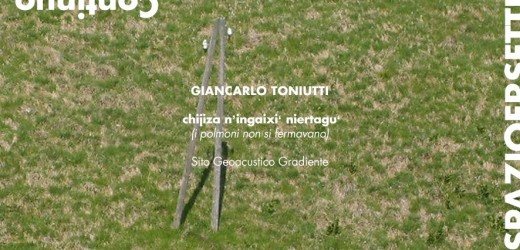The notion of sound-site was developed to respond to an issue that has gradually densified around the growing distance we can observe between space as entertainment place and space as cultural substratum. A notion relating to the very idea of space definition, which is here to be realized through the sound, is then a notion anthropologically oriented.
The apparent inertia in the general sonic progress of this sound-site, speaks to us of an internal time and an external time. The external time, that has an almost ‘geologic’ clock, is a long morphogenetic unfolding deriving from the processes of change, that occur within the structural drift among the different resonant orbits. The internal time, having an ‘elemental’ clock, manifests itself in the constant and irregular motility of the micro-fluctuations of the sound particles, both within each source-line and in the relations settling in the space (defining it).
This sound-site is based on a fundamental mutual relationship among the sources, i.e. among apparently linear motions (descending and ascending, accelerated and decelerated) that each source-line unfolds over a relative cycle. Each gradient forms the driving force of the dynamics, which, in the attraction or repulsion of the singular spectral components, builds, in an approximately perpetual manner, a continuous variation along the axis of a critical density of the space. Generating a sort of curvature onto this temporal double system.
Technically speaking, the sound is played back by 7 loudspeakers placed in the space of the gallery, installed according to different planes, so that the sound can radiate also stratigraphically articulated. In this field complexity no notion of ‘focus’ is sought, no prime listening centre. Rather, on the contrary, the sounds and their articulations (and all the mesostructural processes involved) tend to promote a multifocal listening, or even a multifocal listening field. Where each point of the room can be seen as the listening core, as coalition point for the paths of the sound elements in action. In this way, each listener can experience the various degrees of the variable interactions everywhere in the volume of the room and is to some extent so requested, to find, to his preference, those subjectively optimal coordinates where to linger or along whose trajectories move.
All sounds used in this sound-site come from different recordings realized with a contact microphone onto a single sound source (apart from some occasional accidental environmental phenomena). They are the natural harmonics of the vibrations induced by the electromagnetic ballast of an operating lamp post. The recordings have been subsequently treated with a magnetic tape processing, so as to bring them within the desired frequency range to subject them to a manual continuous glissando process (through the alteration of the magnetic tape speed).
No other electronic processing has been used.
Field-recordings:
Udine, Via Sistiana, 9-10 January 2015
Studio work:
12-24 January 2015 (la stanza nera)
title in Enets, Baj dialect, samoiedic language of North-Central Siberia
Text by Giancarlo Toniutti

Biography: researcher in the field of morphology and composer of electroacoustic experimental music. Since 1979 he releases sound works, performs concerts and realizes sound-sites, lectures and publishes essays in much of Europe and the world. His work is based on a theoretical and materic approach to the sound phenomena, where the acoustic articulation of the collected or generated materials, their morphological organization in moving masses and the timbral-materic research are the nodes of his music compositional processes. Outsider par excellence.
[www.quasi-rn.org]
http://www.spazioersetti.it

